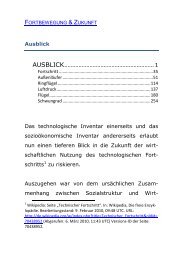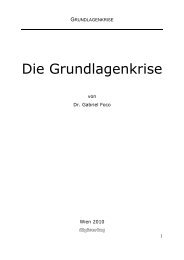Fibonacci - Home
Fibonacci - Home
Fibonacci - Home
Erfolgreiche ePaper selbst erstellen
Machen Sie aus Ihren PDF Publikationen ein blätterbares Flipbook mit unserer einzigartigen Google optimierten e-Paper Software.
Zeta<br />
Der gesuchte Beweis der Riemannschen Vermutung 1 , wonach die nicht trivialen bzw. kritischen (von<br />
s = –2q verschiedenen) Nullstellen der Zetafunktion für σ < 1 dem Streifen angehören<br />
und im komplexen Argument s = σ + ti entlang Realteil σ = ½ seien, hat – über das Euler-<br />
Produkt einen praktischen Zugang über eine Primzahlformel.<br />
Die vergebliche Suche nach der Primzahlformel allerdings zwang zu anderen Näherungsversuchen,<br />
die wiederum aufgrund der für die Zetafunktion vorausgesetzten Identität mit der Primzahlformel<br />
jeweils auf die Primzahlen zurück- oder vorgreifen, und ohne die nämliche Primzahlformel zu kurz<br />
greifen würden.<br />
1<br />
Weisstein, Riemann-Hypothesis, in: < URL >: „It is known that the zeros are symmetrically placed about the line<br />
follows from the fact that, for all complex numbers ,<br />
1. and the complex conjugate are symmetrically placed about this line.<br />
. This<br />
2. From the definition (1), the Riemann zeta function satisfies , so that if is a zero, so is , since then .<br />
It is also known that the nontrivial zeros are symmetrically placed about the critical line , a result which follows from the functional<br />
equation and the symmetry about the line . For if is a nontrivial zero, then is also a zero (by the functional equation), and then<br />
is another zero. But and are symmetrically placed about the line , since , and if ,<br />
then . The Riemann hypothesis is equivalent to , where is the de Bruijn-Newman constant (Csordas et al. 1994).“<br />
3






